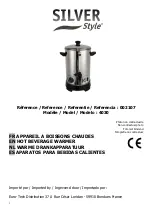
Service Instructions
26
To clean or replace the refill flow control, pull out the elbow-
locking clip and then pull straight up on the elbow. Replace
the elbow locking clip in the slot so that it is not misplaced.
Twist to remove the white flow control retainer. The flow
control can be removed by prying upward through the side
slots of the retainer with a small blade flat screwdriver.
Chemically clean the flow control or the white flow control
retainer using dilute sodium bisulfite or vinegar. Do not use a
wire brush. If necessary, replace the flow control, o-ring on
the flow control retainer, or the o-ring on the elbow.
Reseat the flow control so the rounded end is visible in the
flow control. Reseat the white flow control retainer by push-
ing the retainer into the elbow until the o-ring seats. Remove
locking clip, push down on elbow to reseat and insert locking
clip.
Do not use Vaseline, oils, or other unacceptable lubricants on
o-rings. A silicon lubricant may be used on the o-ring on the
elbow or the white retainer.
Refill Flow Control Assembly or Refill Port Plug
Unscrew the injector cap and lift off. Loosen cap with special
plastic wrench or pliers if necessary. Attached to the injector
cap is a screen. Remove the screen and clean if fouled.
The plug and/or injector can be pried out with a small screw-
driver. The plug can be wiped clean. If the plug leaks replace
the entire plug. The injector consists of a throat and a nozzle.
Chemically clean the injector with vinegar or sodium bisul-
fite. The holes can be blown out with air. Both pieces have
small diameter holes that control the flow rates of water to
insure that the proper concentration of regenerant is used.
Sharp objects, which can score the plastic, should not be used
to clean the injector. Scoring the injector or increasing the
diameter of the hole could change the operating parameters
of the injector.
Two holes are labeled DN and UP. Check for compliance
with one of the following:
a. for downflow systems, the appropriate size injector is
located in the “DN” hole, a plug is in the “UP” hole and
that the piston is a combination of the downflow main pis-
ton and the regenerant piston;
b. for upflow systems, the appropriate size injector is located
in the “UP” hole, a plug is in the “DN” hole and that the
piston is a combination of the upflow main piston and the
regenerant piston; or
c. for backwash only systems, a plug is in the “DN” hole and
in the “UP” hole, and that the piston only has a downflow
main piston (the regenerant piston must be removed) and a
plug is in the refill flow control position.
Push the plug(s) and/or injectors firmly in place, replace the
screen and hand tighten the injector cap.
can be compressed it is easier to use a blunt object (5/8" to 1-
1/8" in diameter) to push the center of the assembly into the
control valve body. The assembly is properly seated when at
least four threads are exposed (approximately 5/8"). Do not
force the spacer stack assembly in. The control valve body
bore interior can be lubricated with silicone to allow for easy
insertion of the entire stack. Do not use silicone or any other
type of lubricant on the red or clear lip seals or the piston.
Reattach the drive cap assembly and piston(s) and the drive
assembly.
After completing any valve maintenance, press and hold
NEXT and REGEN buttons for 3 seconds or unplug power
source jack (black wire) and plug back in. This resets the
electronics and establishes the service piston position. The
display should flash all wording, then flash the software ver-
sion (e.g. 154) and then reset the valve to the service position.
Injector Cap, Screen, Injector Plug & Injector
Содержание WS1-Series
Страница 1: ...Water Softener System Installation Operation Maintenance Manual ...
Страница 13: ...11 Flow Diagrams Service Backwash ...
Страница 14: ...Flow Diagrams 12 Downflow Brine Upflow Brine ...
Страница 15: ...13 Flow Diagrams Rinse Fill ...





































